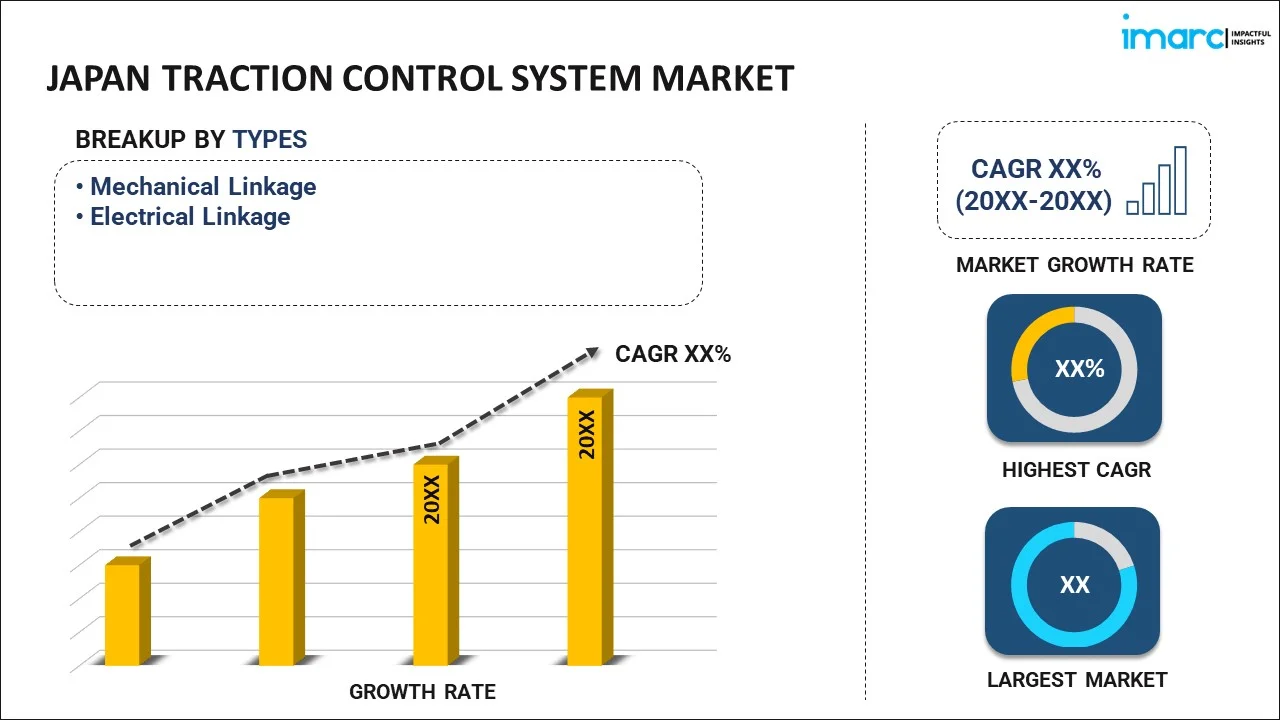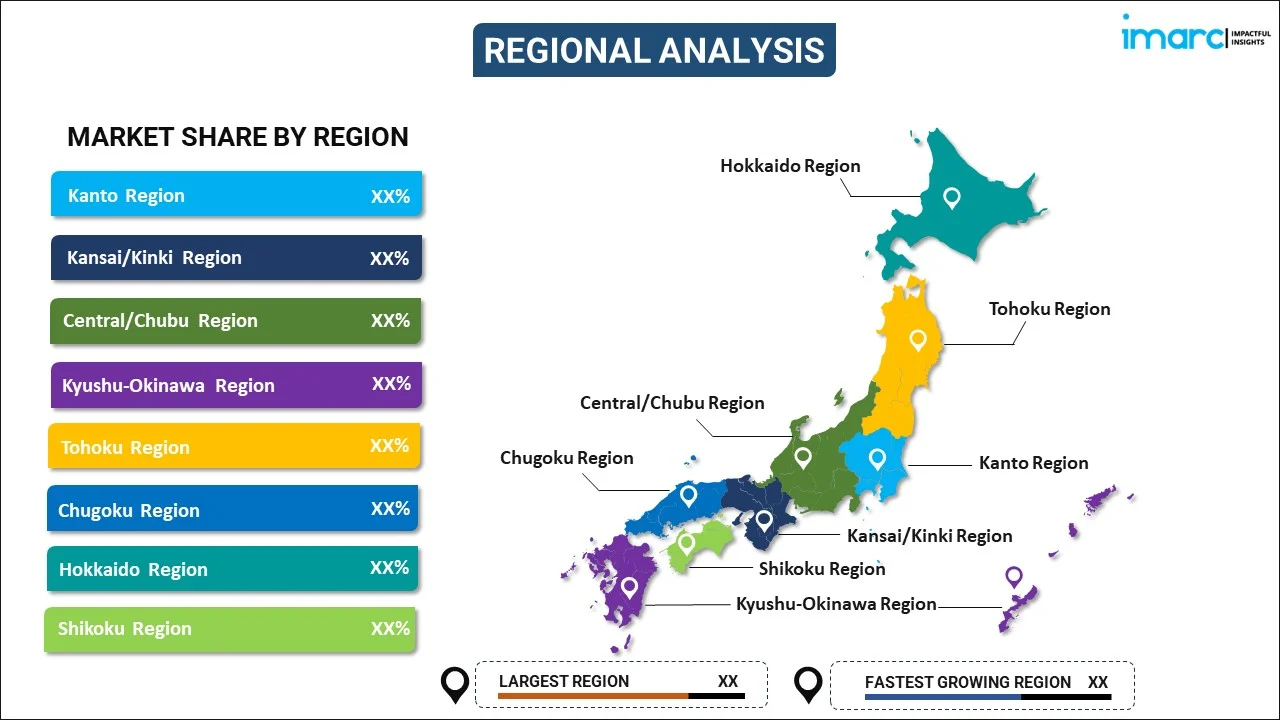
Japan Traction Control System Market Report by Type (Mechanical Linkage, Electrical Linkage), Component (Hydraulic Modulators, ECU, Sensors, and Others), Vehicle Type (ICE Vehicles, Electric Vehicles), Distribution Channel (OEM, Aftermarket), and Region 2025-2033
Market Overview:
Japan traction control system market size reached USD 2.4 Billion in 2024. Looking forward, IMARC Group expects the market to reach USD 4.0 Billion by 2033, exhibiting a growth rate (CAGR) of 5.7% during 2025-2033. The rising demand for electric and hybrid vehicles (EVs/HEVs), stringent safety regulations, continuous technological advancements, increased consumer awareness of safety benefits, growth in autonomous vehicles, development of connected car technologies, and escalating demand for enhanced vehicle stability are factors facilitating the market growth.
|
Report Attribute
|
Key Statistics
|
|---|---|
|
Base Year
|
2024
|
|
Forecast Years
|
2025-2033
|
|
Historical Years
|
2019-2024
|
| Market Size in 2024 | USD 2.4 Billion |
| Market Forecast in 2033 | USD 4.0 Billion |
| Market Growth Rate 2025-2033 | 5.7% |
A traction control system (TCS) is a vital automotive technology designed to enhance vehicle stability and control, particularly in adverse driving conditions. It operates by monitoring wheel speed and adjusting engine power or applying individual brake force to maintain optimal traction between the tires and the road surface. The advantages of TCS are numerous, such as it significantly improves safety by reducing the risk of skidding or losing control in slippery conditions, such as rain, snow, or ice. It aids in preventing excessive tire wear and ensures even distribution of power, enhancing tire longevity. Moreover, it contributes to better fuel efficiency, as it prevents unnecessary wheel spin that can lead to energy wastage. TCS also finds extensive use in commercial and off-road vehicles, where maintaining traction is crucial for safety and performance. There are primarily two types of traction control systems: engine-based and brake-based.
Japan Traction Control System Market Trends:
The Japan traction control system market is influenced by several key drivers, such as the advancements in automotive technology and the increasing emphasis on vehicle safety. Traction control systems, designed to prevent wheel spin and enhance vehicle stability, have become a crucial component in modern vehicles. This is further supported by the growing demand for electric and hybrid vehicles, coupled with the stringent safety regulations imposed by the Japanese government. Moreover, the increasing consumer awareness of the benefits of these systems in improving road safety and vehicle performance is contributing to the market expansion. Furthermore, the continuous innovation and development of traction control technologies by key players in the automotive industry have played a pivotal role in shaping the market landscape. Additionally, the increasing demand for autonomous vehicles and connected car technologies in Japan is providing a considerable thrust to the market growth. Traction control systems are an integral part of the safety systems required for autonomous driving, making them indispensable in the automotive landscape of the future. Apart from this, the shifting inclination towards luxury and high-performance vehicles due to high consumer expenditure income is generating a niche demand for premium traction control solutions, which is positively contributing to the market growth in the country.
Japan Traction Control System Market Segmentation:
IMARC Group provides an analysis of the key trends in each segment of the market, along with forecasts at the country level for 2025-2033. Our report has categorized the market based on type, component, vehicle type, and distribution channel.
Type Insights:

- Mechanical Linkage
- Electrical Linkage
The report has provided a detailed breakup and analysis of the market based on the type. This includes mechanical linkage and electrical linkage.
Component Insights:
- Hydraulic Modulators
- ECU
- Sensors
- Others
A detailed breakup and analysis of the market based on the component have also been provided in the report. This includes hydraulic modulators, ECU, sensors, and others.
Vehicle Type Insights:
- ICE Vehicles
- Electric Vehicles
The report has provided a detailed breakup and analysis of the market based on the vehicle type. This includes ICE vehicles and electric vehicles.
Distribution Channel Insights:
- OEM
- Aftermarket
A detailed breakup and analysis of the market based on the distribution channel have also been provided in the report. This includes OEM and aftermarket.
Regional Insights:

- Kanto Region
- Kansai/Kinki Region
- Central/ Chubu Region
- Kyushu-Okinawa Region
- Tohoku Region
- Chugoku Region
- Hokkaido Region
- Shikoku Region
The report has also provided a comprehensive analysis of all the major regional markets, which include Kanto Region, Kansai/Kinki Region, Central/ Chubu Region, Kyushu-Okinawa Region, Tohoku Region, Chugoku Region, Hokkaido Region, and Shikoku Region.
Competitive Landscape:
The market research report has also provided a comprehensive analysis of the competitive landscape. Competitive analysis such as market structure, key player positioning, top winning strategies, competitive dashboard, and company evaluation quadrant has been covered in the report. Also, detailed profiles of all major companies have been provided.
Japan Traction Control System Market Report Coverage:
| Report Features | Details |
|---|---|
| Base Year of the Analysis | 2024 |
| Historical Period | 2019-2024 |
| Forecast Period | 2025-2033 |
| Units | Billion USD |
| Scope of the Report | Exploration of Historical Trends and Market Outlook, Industry Catalysts and Challenges, Segment-Wise Historical and Future Market Assessment:
|
| Types Covered | Mechanical Linkage, Electrical Linkage |
| Components Covered | Hydraulic Modulators, ECU, Sensors, Others |
| Vehicle Types Covered | ICE Vehicles, Electric Vehicles |
| Distribution Channels Covered | OEM, Aftermarket |
| Regions Covered | Kanto Region, Kansai/Kinki Region, Central/ Chubu Region, Kyushu-Okinawa Region, Tohoku Region, Chugoku Region, Hokkaido Region, Shikoku Region |
| Customization Scope | 10% Free Customization |
| Post-Sale Analyst Support | 10-12 Weeks |
| Delivery Format | PDF and Excel through Email (We can also provide the editable version of the report in PPT/Word format on special request) |
Key Questions Answered in This Report:
- How has the Japan traction control system market performed so far and how will it perform in the coming years?
- What has been the impact of COVID-19 on the Japan traction control system market?
- What is the breakup of the Japan traction control system market on the basis of type?
- What is the breakup of the Japan traction control system market on the basis of component?
- What is the breakup of the Japan traction control system market on the basis of vehicle type?
- What is the breakup of the Japan traction control system market on the basis of distribution channel?
- What are the various stages in the value chain of the Japan traction control system market?
- What are the key driving factors and challenges in the Japan traction control system?
- What is the structure of the Japan traction control system market and who are the key players?
- What is the degree of competition in the Japan traction control system market?
Key Benefits for Stakeholders:
- IMARC’s industry report offers a comprehensive quantitative analysis of various market segments, historical and current market trends, market forecasts, and dynamics of the Japan traction control system market from 2019-2033.
- The research report provides the latest information on the market drivers, challenges, and opportunities in the Japan traction control system market.
- Porter's five forces analysis assist stakeholders in assessing the impact of new entrants, competitive rivalry, supplier power, buyer power, and the threat of substitution. It helps stakeholders to analyze the level of competition within the Japan traction control system industry and its attractiveness.
- Competitive landscape allows stakeholders to understand their competitive environment and provides an insight into the current positions of key players in the market.
Need more help?
- Speak to our experienced analysts for insights on the current market scenarios.
- Include additional segments and countries to customize the report as per your requirement.
- Gain an unparalleled competitive advantage in your domain by understanding how to utilize the report and positively impacting your operations and revenue.
- For further assistance, please connect with our analysts.
 Request Customization
Request Customization
 Speak to an Analyst
Speak to an Analyst
 Request Brochure
Request Brochure
 Inquire Before Buying
Inquire Before Buying




.webp)




.webp)












